There are 9 types of salamanders in Kansas that you can find, endemic to the area. Salamanders like frogs and toads are classified as amphibians, and you can find a total of 61 amphibian species in Kansas.
You will not only find all of the salamanders that live in Kansas’s wilderness in this article, but useful facts about them like how they look, their behavior, and the habitats they are most common in.
Salamanders are very secretive animals, and you may not even know the different types that live in the wild near you. Kansas is known for its rolling hills and vast plains.
There are plenty of freshwater sources like streams, rivers, and lakes that help sustain life like the variety of salamanders. Let’s take a look at the 9 salamanders that live in Kansas, and the interesting things to know about them.
Table of Contents
Salamanders in Kansas
1. Western Tiger Salamander

- Experience Level: Intermediate
- Family: Ambystomatidae
- Scientific Name: Ambystoma mavortium
- Other Names: Yellow-Barred Tiger Salamander
- Adult Size: 6 to 13 inches (15.24 to 33 cm)
- Lifespan: 15 years
- Average Price Range: $80
Western tiger salamanders live all across Kansas, but this species is very hard to find. This species has a large range that covers the central region of the United States, extending into parts of Canada and the United States. Even with their secretive nature this species managed to become the state amphibian in Kansas, named that in 1994.
Forests, fields, grasslands, and other habitats near water sources are where this species lives. They are nocturnal, and most of their time is spent in burrows.
Western tiger salamanders are active most in the spring and fall. Fall and winter is their breeding season, which occurs in wetland and freshwater areas. Water is where their eggs are laid. When hatched they are aquatic, but after metamorphosis they are terrestrial.
This species’ colors vary from olive green, brown or gray. They are a larger salamander, with bars and spots that appear on them yellow in color. The underside of this species is light, or darkly colored. Young larvae also have spots on their sides and tail, along with external gills.
Cannibalism is common with this species, and they have small teeth used to hold onto prey. Other invertebrates like slugs, worms, spiders, and other things that fit into their mouth are what they eat.
2. Eastern Tiger Salamander
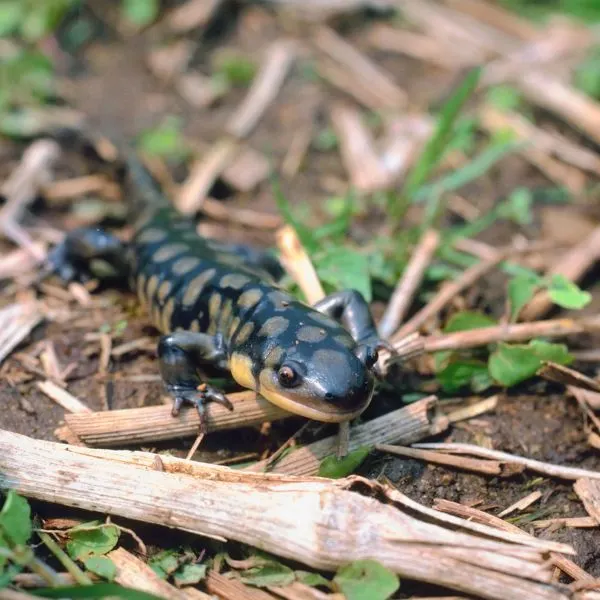
- Experience Level: Intermediate
- Family: Ambystomatidae
- Scientific Name: Ambystoma tigrinum
- Other Names: n/a
- Adult Size: 7 to 13 inches (17.78 to 33 cm)
- Lifespan: 15 years
- Average Price Range: $40
Eastern tiger salamanders are another tiger salamander species that lives in Kansas, and they are most common in the Kansas river. Eastern tiger salamanders are terrestrial as adults, and spend most of their time in burrows. In parts of their overall range this species is listed as endangered due to the destruction of their habitats. This salamander has a stable population overall.
Tiger salamanders are one of the largest species in Kansas, and their colors and markings may vary greatly. Eastner tiger salamanders are covered in spots which are brownish yellow to green yellow. They have thick bodies, with a dark brown base color.
This salamander like other ambystomatids return to the ponds they were born in to breed. Eastern tiger salamanders lay between 25 to 30 eggs, placing them in vegetation. After hatching in about two weeks their larvae are aquatic until completing metamorphosis. Diseases like chytridiomycosis, and ranaviruses are also what this species is vulnerable to, causing the deaths of lots of their larvae.
3. Small-mouthed Salamander
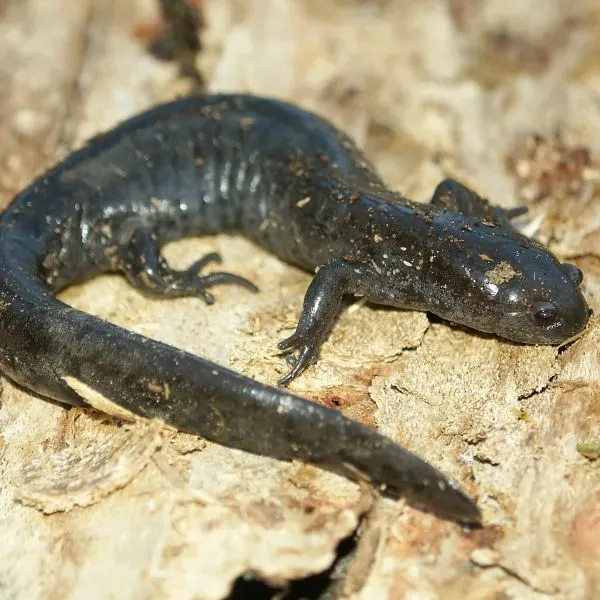
- Experience Level: Intermediate
- Family: Ambystomatidae
- Scientific Name: Ambystoma texanum
- Other Names: Texas salamander
- Adult Size: 4.3 to 7 inches (10.9 to 17.78 cm)
- Lifespan: 15 years
- Average Price Range: $15
Smallmouth salamanders are found in west Kansas, and are endemic to the United States. This species is subterranean, spending most of its life underground when not mating. Breeding occurs in the spring near water, and females are able to lay up to 700 eggs. Smallmouth salamanders have a stable population in their range, found most in forested areas near water.
A medium size species, this salamander has black, dark brown, or gray coloring. Specks of silver or gray appear on their sides. Compared to the rest of their body their heads are small, which is where their common name originates. Smallmouth salamanders have around 14 to 15 costal grooves on them. Their bellies are black with tiny flecks.
Being nocturnal this species only comes out at night, usually when it rains. They feed on insects, slugs, snails, worms, and invertebrates that cross their path. Smallmouth salamanders are very secretive since they share breeding areas with other salamanders.
4. Long-tailed Salamander
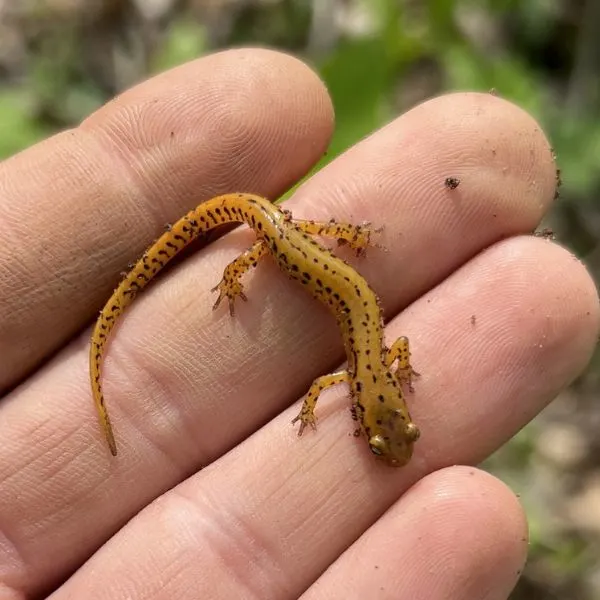
- Experience Level: Intermediate
- Family: Plethodontidae
- Scientific Name: Eurycea longicauda
- Other Names: n/a
- Adult Size: 4 to 8 inches (10 to 20 cm)
- Lifespan: 10 years
- Average Price Range: $30
Longtail salamanders have a small range in Kansas in the Ozark Plateau within the southeast Cherokee county region. This salamander lives near streams, caves, and other moist areas in forests. Adults are terrestrial while their larvae are aquatic. In its range this species has a stable population, but in Kansas they are a threatened species.
Named after their long tail, this species’ total length is around 60% of their tail. They have yellow to orange coloring, with black or reddish spots that appear on them. They have a slender appearance, with a yellow colored plain belly.
Longtail salamanders hide under crevices like rocks, logs, and other debris. They are nocturnal, and prefer to come out on moist nights. This species has been impacted by stripe mining which can cause pollution in their habitats.
5. Spotted Tail Salamander

- Experience Level: Intermediate
- Family: Plethodontidae
- Scientific Name: Eurycea lucifuga
- Other Names: Cave Salamander
- Adult Size: 4 to 8 inches (10 to 20 cm)
- Lifespan: 10 years
- Average Price Range: $75 to $150
Spotted tail salamanders are also called cave salamanders since they live in and beyond the twilight zones in caves. They are also found in forests, and rocky areas near water sources like springs. Found in Kansas, in their overall range they have a stable population, and live mostly in the eastern and southeastern U.S.
Spotted tail salamanders are a long and slender species. They have long tails and orangish coloring. Dot spots cover their back, sides, and tail. On them are around 14 to 15 costal grooves, and their underside has no markings.
Mating for this species is not well studied, but summer is when they are believed to mate. Females can lay between 5 to 120 eggs, which are surrounded by a jelly membrane. Their eggs are laid in water sources like pools and ponds.Snails, flies, beetles, and other small invertebrates are what this salamander eats. When born they are aquatic and it takes between 6 to 18 months to become terrestrial.
6. Grotto Salamander
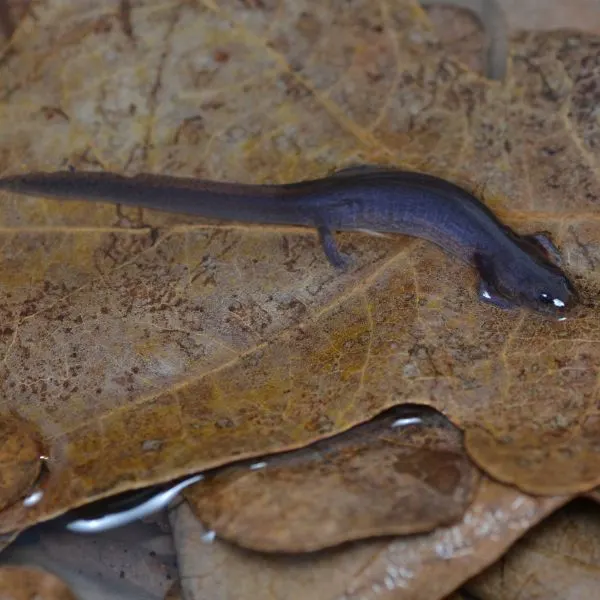
- Experience Level: Advanced
- Family: Plethodontidae
- Scientific Name: Eurycea spelaea
- Other Names: Western Grotto Salamander
- Adult Size: 3.4 inches (8.636 cm)
- Lifespan: 12 years
- Average Price Range: n/a
Grotto salamanders are found in Kansas within the extreme southeastern portion of the state. In their range they mainly live in the Ozark Mountains. Grotto salamanders are terrestrial, living underground in caves. When young this species lives in springs, and streams near the entrances of caves. They have a stable population, within their overall range.
Grotto salamanders have pinkish white coloring, with orangish markings on their tail. They have between 16 to 19 costal grooves, and are medium-sized slender salamanders. When young larvae are brown or purplish, some with yellow flecks on their sides. They have external gills until they complete metamorphosis in around 3 years.
This salamander is very vulnerable to the changes that occur in their water sources, which can lead to depopulation. They are believed to have descended from surface dwelling salamanders, and are not seen often because of their limited niche habitat.
7. Red River Mudpuppy
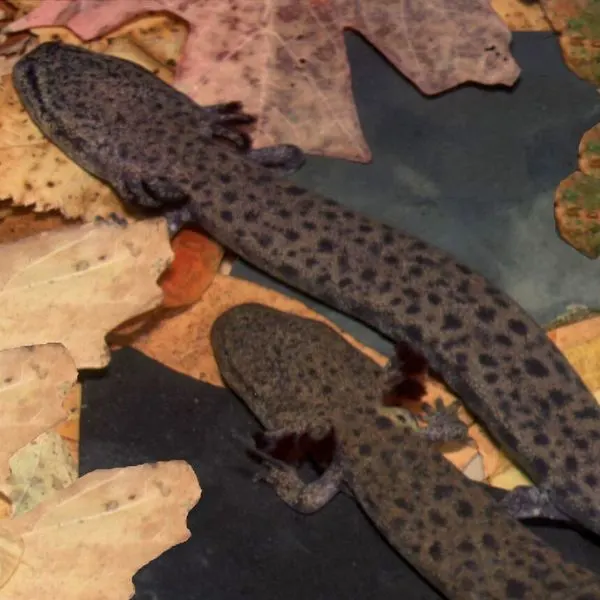
- Experience Level: Intermediate
- Family: Proteidae
- Scientific Name: Necturus louisianensis
- Other Names: Red River Waterdog
- Adult Size: 8 to 12 inches (20 to 30.48 cm)
The Red River mudpuppy is one of two species of mudpuppy that live in Kansas. They are found in the southeastern portion of the state, living in the Red River, and nearby water sources. Red River mudpuppies are close to being an at risk species due to population loss.
This species is gray to brown in color, and is covered in bluish spots. They have a light yellow stripe that appears on their sides. Red River mudpuppies have elongated bodies, and small limbs that help them move around the water’s bottom surface.
Red River mudpuppies are able to go on land, but cannot survive for long since they are mainly aquatic. They will only go on land if their home is dirty, to try and find a cleaner water source. Small invertebrates they come across are what this species eats.
8. Common Mudpuppy
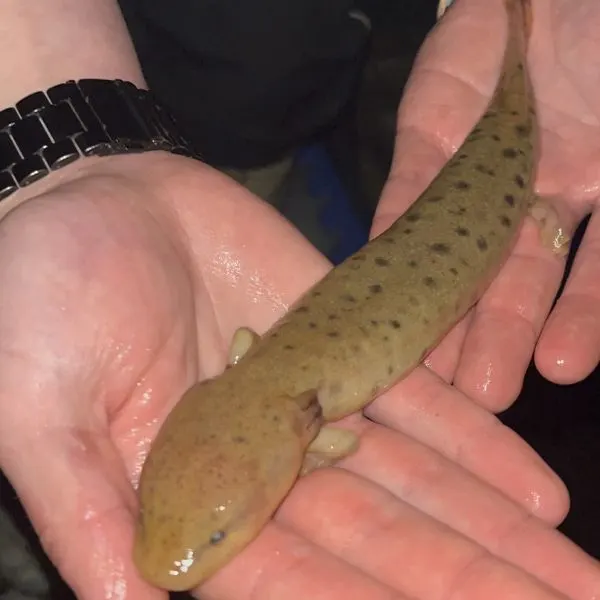
- Experience Level: Intermediate
- Family: Proteidae
- Scientific Name: Necturus maculosus
- Other Names: Waterdogs
- Adult Size: 8 to 19 inches (20.3 to 48.2 cm)
- Lifespan: 15 to 30 years
- Average Price Range: $10 to $20
Common mudpuppies in Kansas are only found in the Marais des Cygnes, Verdigris, and Neosho drainage basins in the state. This species is fully aquatic, spending all of its life in water.
Common mudpuppies are one of two mudpuppy species in the state. They are rarely seen, and being nocturnal during the day they hide under natural debris like rocks.
This salamander has red external gills that stick out the sides of their head, and an elongated body. They have small limbs, with four toes on each foot. Their coloring is dark brown and rusty looking, with grayish spots on them.
Spending all their life in water the common mudpuppy feeds on things like crayfish, small fish, and aquatic insects. They have small teeth to hold onto prey. This salamander is susceptible to predators like water birds, snakes, frogs, and larger fish.
9. Eastern Newt
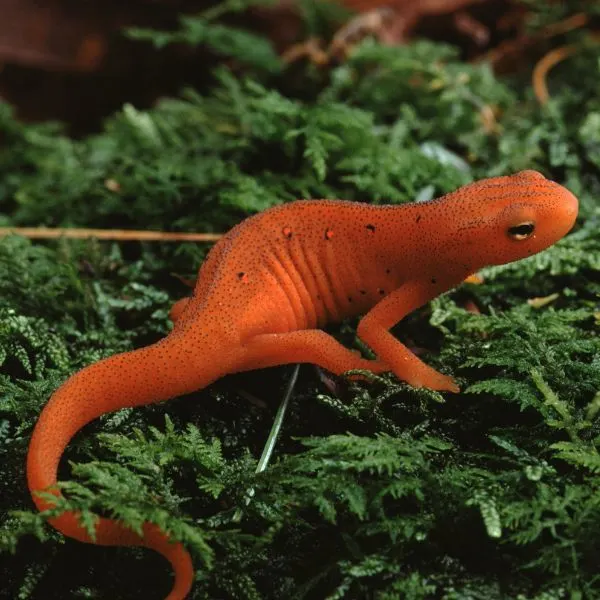
- Experience Level: Beginner
- Family: Salamandridae
- Scientific Name: Notophthalmus viridescens
- Other Names: n/a
- Adult Size: 3 to 6 inches (7 to 12.4 cm)
- Lifespan: 15 years
- Average Price Range: $20 to $30
The eastern newt is the only newt species that lives in Kansas, and they have a large range that covers the eastern United States. Adults and larvae are aquatic, and this species also goes through an eft stage where they live on land. Lakes, ponds, and other freshwater habitats near forests are where this salamander lives.
As a larvae the eastern newts have gills, and olive green to brown color. As an eft, this species sheds its gills, and has orange, or bright red color. Orangish spots bordered by black cover them, and they have rough skin. Adults have olive green skin, and yellowish coloring. Spots also cover adults and they have slimy skin.
Eastern newts use their toxins to defend themselves from predators, and their coloring acts as a warning. They feed on things like eggs, worms, other amphibians, and insects. Most of this species dies when in their larval form, and only 2% make it to the eft stage.
FAQ
Do Hellbenders live in Kansas?
The hellbender (Cryptobranchus alleganiensis) is the largest salamander that lives in North America, and no specimens have been documented in Kansas. The hellbenders that were thought to be in the state were actually of another species. This salamander is absent from Kansas.
Are there newts in Kansas?
The eastern newt (Notophthalmus viridescens) is the only newt species that lives in Kansas. They are also the only salamanders in the state that have larvae, eft, and adult stages. Eastern newts are a threatened species in the state, and they are found on land, and in water.
In Kansas where are salamanders found?
Salamanders in Kansas and other parts of the United States are found near water sources like creeks, ponds, brooks, rivers, lakes, and streams. They are most typical in forest areas, and depending on the species you will find them on land or in the water. Secretive in nature salamanders usually come out on rainy nights. During the day you can find them hiding under moist debris like rocks, logs, and leaf litter.
Wrapping up
In the wild, there are 9 salamanders that live in Kansas, and like other amphibians in North America, they are at risk of depopulation. The destruction of habitats, diseases, pollution, and climate change are what is causing the population loss of many of the North Americas amphibians. Some salamanders are common, but as these threats persist more species may become at risk, and soon be endangered.
Protecting the home, and learning about where salamanders live in Kansas is essential in preserving the beautiful wildlife found in the state. Salamanders are important parts of a greater ecosystem. They feed on a plethora of different invertebrates and are a valuable food source for snakes, small mammals, and other animals.
While you can keep a salamander as a pet, you should never take one from the wild. Wild-caught salamanders are prone to diseases, and parasites, and generally die quicker. Learning about the salamanders in Kansas allows you to find out which are good pets, but also can help you identify and find them in the wild.
Other nearby states
